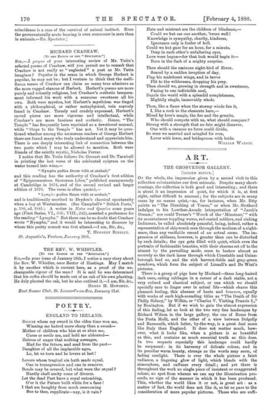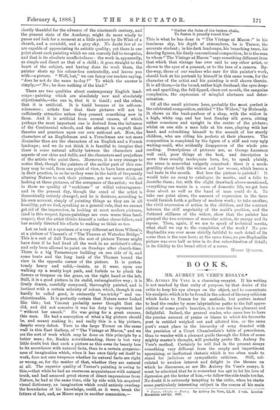ART.
THE GROSVENOR GALLERY.
[SECOND NOTICE.] ON the whole, the impression given by a second visit to this collection substantiates our first estimate. Despite many short- comings, the collection is both good and interesting ; and there is about it an impression of quiet, for which it is, at first sight, rather difficult to account ; for the subjects are in many cases by no means quick—as, for instance, when Mr. Etty paints us "The Disrobing of Venus," or when Mr. Stothard indulges in his Lowther-Arcade interpretation of "Jacob's Dream ;" nor could Turner's "Wreck of the 'Minotaur,'" with its mountainous toppling waves, red-coated soldiers, and sinking Indiaman, be called absolutely peaceful, being, indeed, rather a. representation of shipwreck seen through the medium of a night- mare, than any verifiable record of an actual scene. The im- pression of stillness, however, is greater than can be disturbed by such details ; the eye gets filled with quiet, which even the portraits of fashionable beauties, with their charms set off to the utmost by the prevailing mode, seem to bestow almost as securely as the dark lanes through which Constable and Gains- borough lead us, and the rich harvest-fields and gray-green meadows, which form the subject of Linnell's and De Wint'a pictures.
There is a group of pigs here by Morland—three long-haired dark ones, eating cabbages in a corner of a dark stable, not a. very refined and classical subject, or one which we should specially care to linger over in actual life—which shares this pleasant feeling, this absence of haste and bravura, equally with works of such high-sounding titles as "The Death of Sir Philip Sidney," by Wilkie, or "Charles V. Visiting Francis I.," by Bonirigton. But if we wish to gain the utmost expression of this feeling, let us look at the two very fine landscapes by Richard Wilson in the large gallery, the one of Rome from the Porta Molli, and the other of a view between Dolgelly and Barmouth, which latter, by-the-way, is a great deal more like Italy than England. It does not matter much, how- ever, what it looks like, when a picture is as beautiful as this, and contains as much essential truth as this does. In two respects especially this landscape could hardly be surpassed : in its harmony of delicate colour, and in its peculiar warm beauty, strange as the words may seem, of fading sunlight. There is over the whole picture a faint radiance, a lingering glow of light, which blends with the atmosphere, and suffuses every detail ; and yet there is throughout the work no single piece of insistent or exaggerated colour, no spot from whence we can say the illumination pro- ceeds, no sign of the manner in which it has been produced. This, whether the world likes it or not, is great art : as a matter of fact, the world does not like it, so let us pass to the. consideration of more popular pictures. Those who are suffi-
ciently thankful for the advance of the nineteenth century, and the present state of the Academy, might do more wisely to pause and look for a moment at a little picture by Be Wint of a church, and a cornfield, and a grey sky. No doubt few of us are capable of appreciating its artistic quality; yet there is one point about such painting which we can scarcely fail to recognise, and that is its absolute unaffectedness : the work is, apparently, as simple and direct as that of a child ; it goes straight to the heart of the subject, and having done its work there, the painter shuts up his colour-box contentedly, and leaves you with—a picture. "Well, but," we can fancy our readers saying, "does he not do the same to-day ?" To which the answer is simply,—" No; he does nothing of the kind."
There are two qualities about contemporary English land- scape - painting which are absolutely new and absolutely objectionable,—the one is, that it is timid ; and the other, that it is artificial. It is timid because of its self-con- sciousness; artists fear that their pictures will not be sufficiently attractive unless they present something new in them. And it is artificial from several causes, of which perhaps the most important one is derived from the influence of the Continental schools, and the attempt to engraft their theories and practices upon our own national art. Now, the characters of an Englishman and a Frenchman are not more dissimilar than are the characters of an English and a French landcape ; and we do not think it is fanciful to imagine that there is some natural affinity between the characters and aspects of our skies and fields, and the characters and prejudices of the artists who paint them. Moreover, it is very strange to notice that, though the painters of the earlier part of this cen- tury may be said, from one point of view, to have been arrogant in their practice, in so far as they were in the habit of frequently altering Nature to suit their pictures, yet we never think, on looking at these pictures, of the arrogance of the artist ; we find in them no quality of " cockiness " or wilful extravagance : and in the present day, though the creed of the artist is theoretically entirely changed, and he is desirous, according to his own account, simply of painting things as they are in all humility, yet we find, speaking as a general rule, that we cannot get rid of the impression, in looking at most modern pictures, (and in this respect figure-paintings are even worse than land- scapes), that the artist thinks himself a rather clever fellow, and has mainly directed his efforts to making us think so too.
Let us look at a specimen of a very different art from Wilson's, at a picture of Vincent's of "The Thames at Waterloo Bridge." This is a sort of dull Turner, the sort of picture Turner might have done if he had lived all the week in an architect's office, and only been allowed to paint on Sundays after church-time. There is a big Turneresque building on one side of it, and some boats and the long bank of the Thames bound the view in the opposite corner of the picture. It is porten- tously heavy and solid,—insists, as it were, upon our walking up a neatly kept path, and forbids us to pluck the flowers or trespass on the grass, on the right hand or the left. Still, it is a good picture in its stolid, unimaginative way ; it is firmly drawn, carefully composed, thoroughly painted, and is instinct with a certain sobriety of colour, which, though it can hardly be called good, is eminently " un-tricky " and un- objectionable. It is perfectly certain that Nature never looked like this ; but Vincent probably never thought that she did, and did not conceive it was his duty to represent her
without her smock." He was going for a great success, this man. He had a conception of what a big picture should be, and meant making it; and really this is a big picture, despite every defect. Tarn to the large Turner on the same wall in this East Gallery, of "The Vintage at Macon," and we see the sort of work which may be done on this principle by a better man ; for, Ruskin notwithstanding, there is but very little doubt but that such a picture as this owes its beauty less to its accordance with natural facts, than to a certain gorgeous- ness of imagination which, when it has once fairly set itself to work, does not care twopence whether its natural facts are right -or wrong, or, for the matter of that, whether they are natural at all. The superior quality of Turner's painting is owing to this,—that while he had an enormous acquaintance with natural truth, and had amassed great stores of direct impressions from Nature, he had at the same time, side by side with his acquired visual dictionary, an imagination which could entirely overleap the boundaries of his knowledge, could, as it were, break the fetters of fact, and, as Moore says in another connection,—
" Gather the links of the broken chain, To fasten it proudly round him."
This is what he has done in "The Vintage at Macon :" in his luminous sky, his depth of atmosphere, he is Turner, the accurate student ; in his dark landscape, his branching trees, his dancing figures, his finely conventional composition, he is the man to whom" The Vintage at Macon " says something different from that which that vintage has ever said to any other artist, or shown to the eyes of a peasant, or to the lens of a camera. By- the-way, those of our readers who care for this painter's work, should look at his portrait by himself in this same room, for the character of the artist and his painting is well shown therein. It is all there,—in the broad, rather high forehead, the eyes deep- set and sparkling, the full-lipped, clean-cut month, the sanguine complexion, the expression of mingled alertness and deter- mination.
Of all the small pictures here, probably the most perfect is the celebrated composition, entitled "The Widow," by 3/already. It shows us the back-parlour of a shop, with the widow in a high, white cap, and her best Sunday silk gown, sitting rather conscious and upright in the centre of the picture ; whilst on one side a man lolls at his ease, playing with her hand, and submitting himself to the assault of her sturdy children, who are rifling his pockets at their pleasure. The composition is completed by the figure of a stiff and very ugly waiting-maid, who evidently disapproves of the whole pro- ceeding. Descriptions of pictures are, as George Laurence well said, poor things at the best, and description is more than usually inadequate here, for, to speak plainly, the scene is somewhat vulgarly conceived : there is a mock- gentility about both the widow and her wooer, which leaves a bad taste in the mouth. But how the picture is painted ! It would take an essay to catalogue its merits, and a folio to describe them ; for, with the slight drawback above-mentioned, everything one wants in a scene of domestic life, we get here done about as well as the hand of man could do it. To take one point alone, the amount of expression in the faces would furnish forth a gallery of modern work ; to take another, the vivid expression of action in the children, and the contrast between the stiff angularity of the maid's position, and the fluttered stillness of the widow, show that the painter has grasped the two extremes of muscular action, its energy and its repose. Then, again, if we are to speak of technical merits, what shall we say to the completion of the work? No pre- Raphaelite was ever more strictly faithful to each detail of its scene than is the case here; at the same time, no pre-Raphaelite picture was ever half so true in its due subordination of detail; in its fidelity to the broad effect of a scene.
BARRY QUILTER.



































 Previous page
Previous page